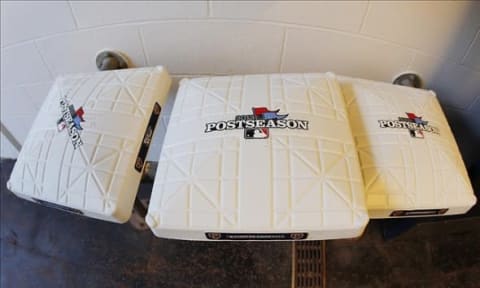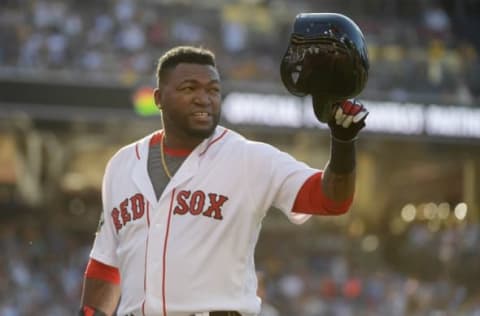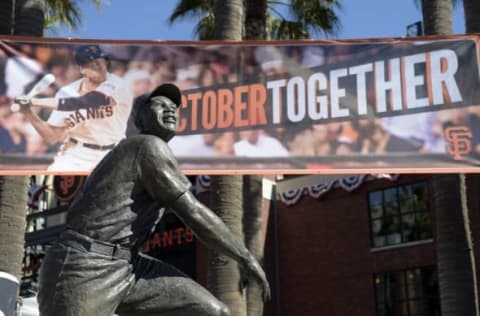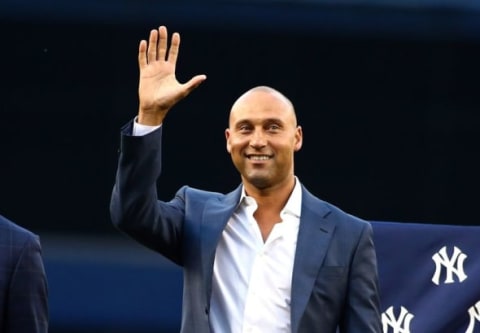MLB Playoffs: Top 10 Moments in MLB Postseason History


Relive the most exciting moments in MLB postseason history, while watching new memories unfold in the 2016 playoffs.
With the 2016 MLB postseason underway and new heroes beginning to emerge, fans of all franchises remember the memories of past playoffs. Whether it’s a walk-off home run or incredible pitching performance, narrowing down the number of exciting postseason moments is no easy task.
These moments are in no particular order, as the order of the top ten MLB playoff moments likely depends a lot on which team you have grown up rooting for, and how long you’ve been alive. Rather than make a subjective list, these ten are what I believe to be the ten best moments in postseason history.
This was no easy task, but hopefully you’ll have some fun reliving some of the best moments that playoff baseball has had to offer.
1905 World Series – Christy Mathewson’s Hat Trick
Coming off an utterly dominant season, Christy Mathewson carried the New York Giants to their third World Series title in 1905. However, he did it in such a way that baseball has yet to see a similar performance since.
During the regular season, Mathewson went 31-9 and led the Major Leagues with a 1.28 ERA. Pitching 32 complete games and eight shutouts, Mathewson was well suited to make history in the Fall Classic. In just his sixth season in the Major Leagues, Mathewson pitched three complete game, shutouts against the Philadelphia Athletics.
He went 3-0 with 18 strikeouts and 13 hits as the Giants cruised to the title. Continuing to dominate through his 17-season career, Mathewson is known as one of the greatest pitchers to take the mound.

2004 ALCS – Red Sox Break the Curse of the Bambino
Up until 2004, any team that faced a 3-0 deficit in the postseason ended up being sent home defeated. The Boston Red Sox faced that series deficit to their archrival New York Yankees in the 2004 ALCS, but they did not go home defeated.
In 2004, Red Sox became the first, and only, team in postseason history to come from that far behind and win the series. Winning four, must-win games in a row, Boston achieved the greatest comeback in postseason history.
Two moments shaped the series in favor of the Red Sox. In
, Boston managed to tie the Yankees in the bottom of the ninth off of
. The game remained tied 4-4 until
won the game with a two-run four-bagger in the bottom of the 12
th
.
Earlier in the playoffs, Curt Schilling suffered a tendon injury in his right ankle. He was clearly in pain as the Yankees jumped on him in Game 1 of the ALCS. Determined to face the Yankees again, Schilling underwent a pre-game surgery before Game 6 to suture the tendon to his ankle. Not only did his start tie the series, but he pitched the most heroic outing in postseason history.
As blood gradually soaked up his sock, Schilling battled the pain, pitched seven innings and allowed only one run. That game later came to be known as the “Bloody Sock Game”.
The Red Sox followed through on their epic comeback to win their first World Series since 1918. Ironically, the same team they traded the Bambino to in 1919 was the same team they came back to beat in the ALCS.
1932 World Series, Game 3 – The Babe Calls His Shot?
The most memorable and mysterious home run came form the bat of Babe Ruth in Game 3 of the 1932 World Series. Not only was Ruth coming off of his seventh consecutive 40-plus home run season, but his club was highly favored against the Chicago Cubs in the Fall Classic. Their superiority showed in New York, taking the first two games by three runs or more.
As the series shifted to Chicago, tensions were high from both the Cubs’ dugout and the crowd at Wrigley Field. Even before the game, fans were heckling Ruth by throwing lemons at him during batting practice. Although he put the Yankees up in the top of the first with a three-run homer, his infamous home run was still to come.
By the time Ruth came up to bat in the fifth inning, the Cubs managed to even the score 4-4. Legend has it that after the first four pitches of the at bat, Ruth pointed to the right-field bleachers, showing the crowd where he intended to hit his home run. Whether he was pointing to the bleachers or at pitcher Charlie Root, the Babe sent the fifth pitch of the at bat right where he pointed.
His home run fueled the Yankees to a 7-5 win in Game 3 and they went on to sweep the Cubs for their fourth World Series title. While many believe that there was no way he called his shot, the legend still captures the imagination of baseball fans to this day.

1954 World Series, Game 1 – The Catch
A strong second half of the season won the New York Giants a ticket to the 1954 World Series. Facing the Cleveland Indians, Willie Mays dazzled fans at Polo Grounds with the most memorable catches in postseason history.
The Indians jumped on the board with two runs in the first inning, but the Giants answered with two of their own in the third. With the game tied 2-2, Vic Wertz came up to the plate with runners on first and second in the top of the eighth. Wertz hit a deep fly ball that would have landed in the stands of every modern ballpark. Minute Maid Park brags the deepest centerfield in the Major Leagues at 436 feet. In comparison, the centerfield at Polo Grounds stretched out to 483 feet.
To the surprise of his teammates, the fans and even broadcaster Jack Brickhouse, Mays reached out to make an incredible over the should catch. Instinctively, Mays threw the ball back to the infield and kept the Indians from taking the lead. In fact, the Giants went on to win the game in extra innings, and sweep the Indians.
The play was simply remembered as “The Catch”.

2001 World Series, Game 4 – “Mr. November”
Although the Arizona Diamondbacks went on to win the 2001 World Series, nothing could overshadow Derek Jeter’s transformation into “Mr. November”. On October 31 in New York, the Yankees trailed Arizona 3-1 going into the ninth inning of Game 4.
With one man on and two outs, the Diamondbacks gave up a game-tying, two-run homer to Tino Martinez. As the Yankees held the Diamondbacks scoreless in the top of the tenth, the clock inched closer to midnight.
With two outs, Jeter came to the batter’s box right as the clock struck midnight, marking the first baseball game to be played in November. From there, the game came to a quick end as Jeter gave the Yankees the win with a walk-off home run in the bottom of the tenth.
Jeter’s home run marked the first home run to be hit in the month of November, thus the nickname “Mr. November”.
1956 World Series, Game 5 – Larsen’s 27 Outs
After struggling through his first three years in the Major Leagues, Don Larsen was an unlikely candidate to throw the postseason’s only perfect game. Finishing 10-33 with the Saint Louis Browns and Baltimore Orioles, Larsen was traded to the New York Yankees in 1955. During his second season with the Yankees, Larsen helped push the Yankees to the 1956 World Series by going 11-5 with a 3.26 ERA.
His regular season success earned him the spot as the Yankees’ No. 2 starter against the Brooklyn Dodgers. Although he struggled against the Dodgers in Game 2, giving up four unearned runs through 1.2 innings, he redeemed himself in Game 5.
With the series tied two games apiece, Larsen gave the Yankees the edge with his historic start. Pitching against many future Hall of Famers in the Dodgers’ lineup, Larsen pitched the only perfect game in postseason history. Shutting down Jackie Robinson, Roy Campanella, Duke Snider and Pee Wee Reese, Larsen struck out seven Dodgers en route to the Yankees’ narrow 2-0 victory in Game 5. Although they lost Game 6 by one run, the Yankees went on to blank the Dodgers in Game 7 for the World Series championship.
Larsen earned the World Series MVP honors for his perfect game and will be forever remembered in postseason history.
1991 World Series, Game 7 – Morris Goes Nine and Then Some
Pitching a complete game shutout is impressive enough, but, with the 1991 World Series on the line, Jack Morris went one step further. Towards the end of his career, Morris spent a solo season with the Minnesota Twins after pitching his first 14 seasons with the Detroit Tigers. Finishing the season 18-12, Morris delivered two wins in the ALCS and pushed the Twins to the World Series.
Morris took the mound for Game 1 against the Atlanta Braves and threw seven innings with only two runs and five hits. Three games later, Morris received the no decision in Game 4 as the Braves tied the series.
Splitting the next two games, the Twins gave the nod to Morris to start the deciding Game 7. Morris battled against John Smoltz through the first six innings until the Braves turned to their bullpen in the seventh. As Morris held the Braves scoreless, so were the Twins and the game was sent into extra innings.
After Morris threw eight pitches in the top of the 10th inning, Gene Larkin’s pinch-hit, walk-off single rewarded one of the most impressive starts in postseason history. Morris pitched 10 innings, allowed only seven hits, two walks and struck out eight off of 126 pitches.
Even after Morris was traded to the Toronto Blue Jays and finished his career with the Cleveland Indians, the Twins remember his historic Game 7 performance fondly.
1975 World Series, Game 6 – Fisk Waves His Homer Fair
Not even a loss to the Cincinnati Reds in the 1975 World Series could overshadow the walk-off home run hit by Carlton Fisk.
With a one-game deficit in the series, the Boston Red Sox were in the fight for their lives in Game 5. The Red Sox put up three runs in the bottom of the first, but so did the Reds in the top of the fifth to tie the game 3-3. The Red would take a 6-3 lead over Boston by the eighth inning, but another three-run inning by the Red Sox forced the game into extra innings.
Fast forward to the bottom of the 12th inning, Fisk came up to the plate and rocketed the second pitch of the at bat towards the left field pole. From the stands, it looked as if the ball would drift foul. However, while Fisk jumped and waved his arms towards fair territory, the ball knocked off the foul pole for the game-winning home run. The footage of Fisk has become the essence of postseason excitement.
1968 World Series, Game 1 – Gibson Sits Down 17
Coming into the 1968 World Series against the Detroit Tigers, Bob Gibson pitched the greatest season of his career. He finished the season 22-9 with a career-low 1.12 ERA and 268 strikeouts, earning him the NL Cy Young and NL MVP honors. Not only was 1968 the best season of his career, but is seen by many as the greatest in baseball history.
Surprisingly, the best was yet to come as Gibson started Game 1 for the Saint Louis Cardinals. Gibson won Game 1 with a complete game shutout, in which he set a postseason record with 17 strikeouts. Fanning each Tiger at least once, Gibson gave up only five hits and one walk.
Although he was outdueled in Game 7 and Detroit took home the title, Gibson’s Game 1 performance is unmatched as the most dominant start in postseason history.
1988 World Series, Game 1 – Gibson Limps Up, Walks Off
It is clear that the postseason can bring the worst and the best out of any player. Although an injury held Kirk Gibson from the amount of World Series playing time he deserved, he helped fuel the Los Angeles Dodgers to a World Series championship in 1988.
Coming off a phenomenal season that earned him the NL MVP honors, Gibson suffered an injury to his right knee sliding into second base in the NLCS against the New York Mets. Twisting his knee as he slid into second formed a bruise that resulted in tendinitis. Consequently, Gibson had his playing time in the World Series limited to one pinch-hit at bat.
And he did not waste it.
Leading the Dodgers 5-4 in Game 1 of the World Series, the Oakland Athletics looked to secure their win by putting in Dennis Eckersley. Eckersley led the Major Leagues with 45 saves and came in second for the 1988 Cy Young award voting. Needless to say, he was not the kind of pitcher to blow close games.
Next: Top 5 Biggest Postseason Threats
However, a two-out walk proved fatal for Eckersley as Gibson limped to the batter’s box. Gibson worked Eckersley to a full count before sending the Dodgers home with a walk-off, two-run home run. As Gibson hobbled around the bases pumping his fist, the Dodgers went on to win the World Series in fives games.